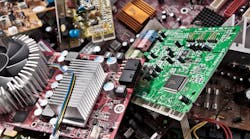Focused on procuring raw materials and other goods that their companies need to be able to make their own products, electronics buyers don’t always get to see the electronic waste or “e-waste” that starts to pile up when technology becomes obsolete, inoperable, or otherwise unusable.
But it’s there. In fact, e-waste is accumulating at an alarming rate in our tech-centric world, where applications, equipment, and electronics can become obsolete almost as quickly as they are brought to market.
What Is E-Waste?
According to Earth911, e-waste is defined as “any electronic waste that is no longer wanted or is now obsolete, whether it works or not.” That includes, but isn’t limited to, TVs, VCRs, DVD players, stereos, copiers, fax machines, tablets, computers, and mobile phones. Not always easy or convenient to recycle—local governments often have e-waste collection days a few times a year—this type of waste tends to gather dust until someone unceremoniously tosses it out with the “regular” trash.
The amount of e-waste that hits U.S. landfills every year is staggering. Earth911 says Americans throw away 9.4 million tons of electronics every year, and that simply recycling one million laptops would save the energy equivalent to the electricity used by 3,657 U.S. homes in a year, according to the EPA.
Only 12.5% of e-waste is recycled, making it one of the fastest-growing segments in the municipal solid waste stream. “Although nearly 100% of e-waste is recyclable, the current recycling rate of e-waste is not promising,” The Balance reports, noting that the items that can be recovered from e-waste include constituents such as plastics, metals, and glass.
Problem Solvers
E-waste is problematic because it usually contains toxic materials. Hundreds of different materials are used to make electronics and their components, including heavy metals, gases, plastics, chlorinated solvents, and more, according to Planet Green Recycle. Some of the most common toxic materials found in electronic waste include mercury, lead, beryllium, cadmium, and brominated flame retardants (BFRs).
One Stanford researcher is trying to help stem the flow of e-waste into the world’s landfill with a new, biodegradable semiconductor that would fully degrade when it comes into contact with a weak acid such as vinegar, according to a report in New Atlas. Zhenan Bao and her team in the Stanford lab have been experimenting with different types of next-gen applications “inspired by the human skin,” New Atlas’ Lisa-Ann Lee writes, “from a stretchable electrode that could help prostheses users regain their sense of touch to paper-thin heart sensors and self-healing, pressure-sensitive plastic polymers.”
As part of that experimentation, Bao has been trying to mimic the function of human skin to think about how to develop future electronic devices, and how to combine electronic properties with biodegradability. “We came up with an idea of making these molecules using a special type of chemical linkage that can retain the ability for the electron to smoothly transport along the molecule,” Bao told New Atlas, adding that the chemical bond “is sensitive to weak acid—even weaker than pure vinegar.”
While still a work in progress, this new semiconductor could help introduce biodegradability into various applications, thus helping to reduce e-waste during an era where the number of electronics in use—and, ready to toss out—continues to exacerbate every year.










